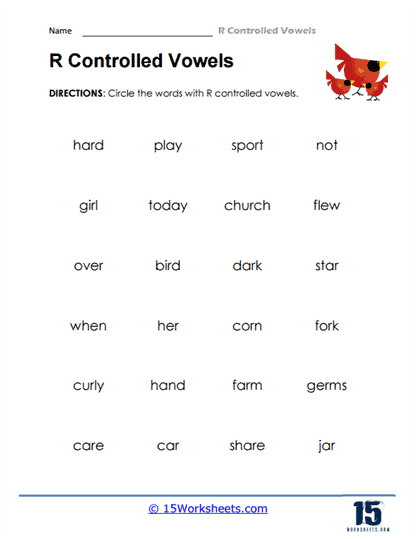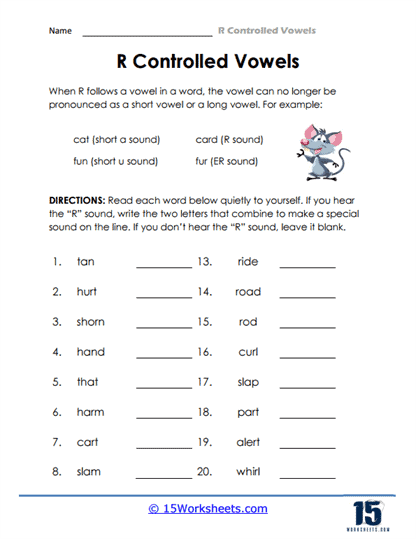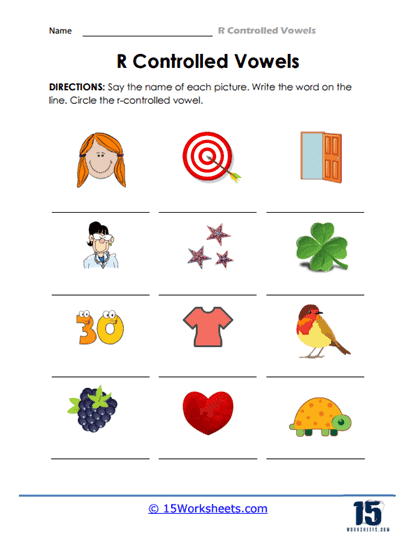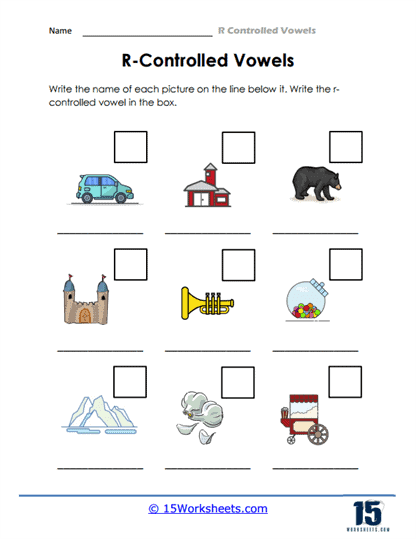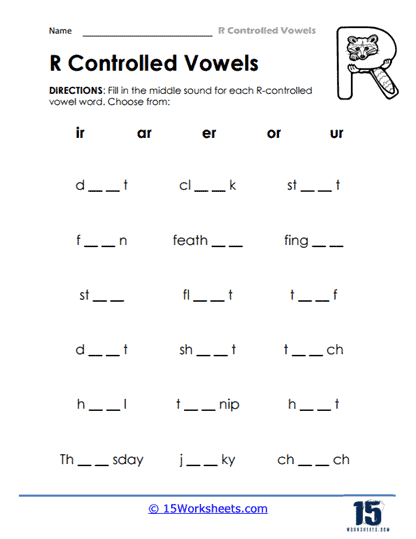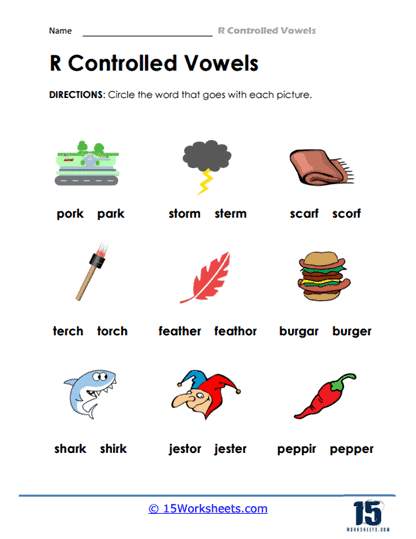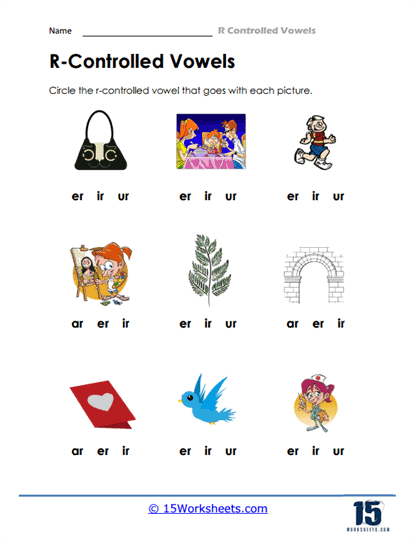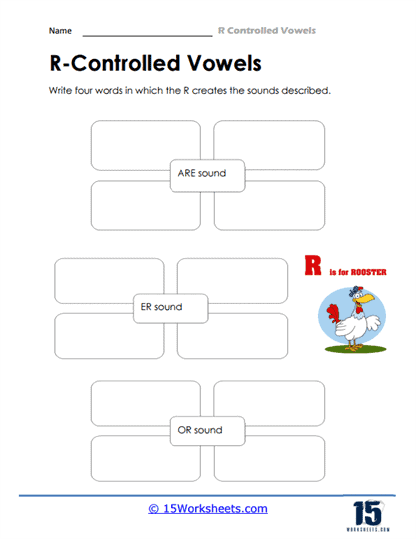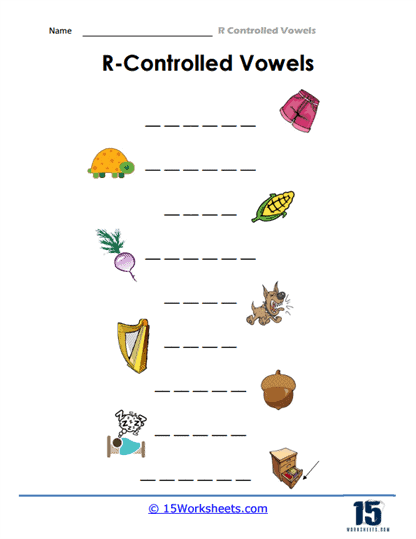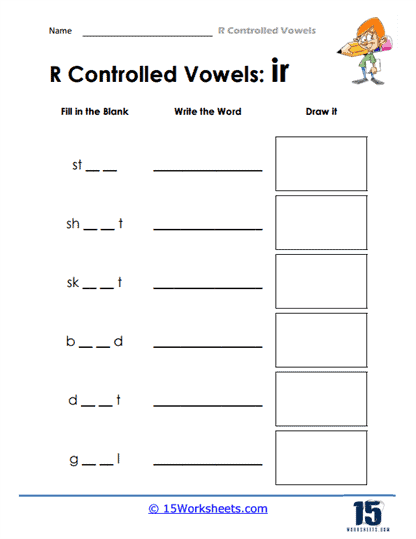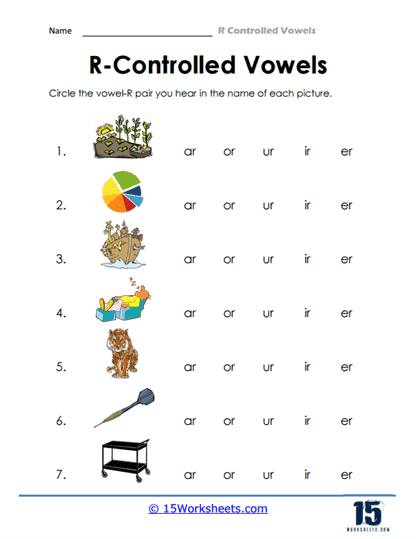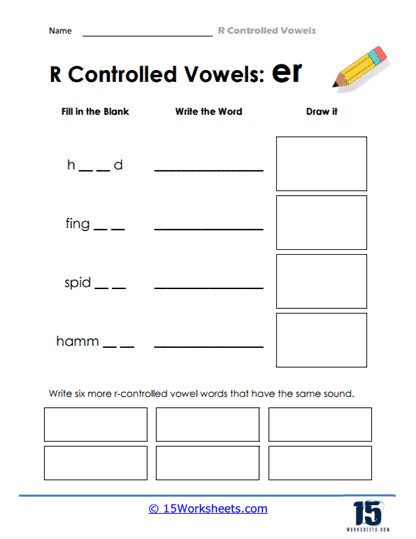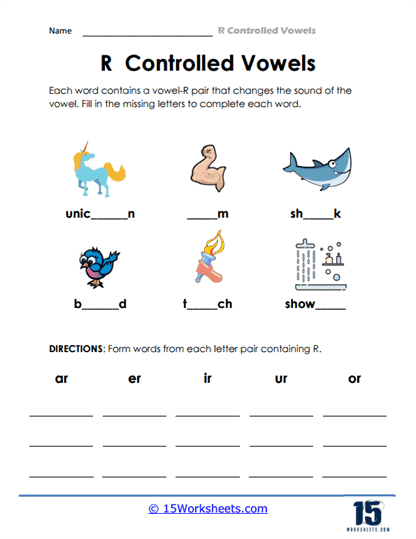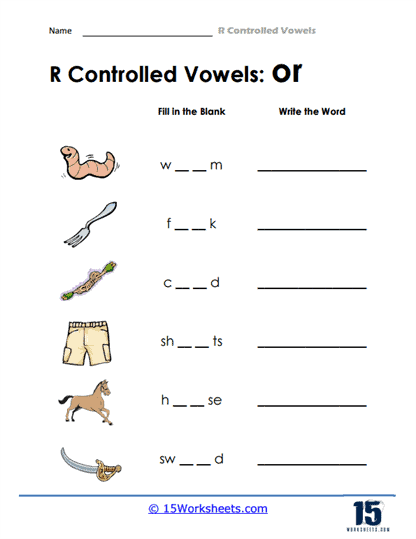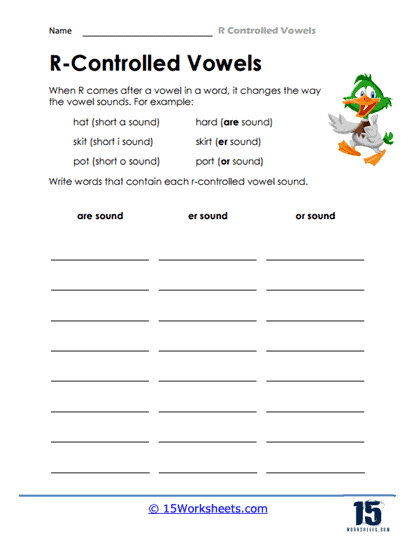R Controlled Vowels Worksheets
All About These 15 Worksheets
These worksheets will help students understand and master one of the more challenging aspects of English phonics: the r-controlled vowel sound. When a vowel is followed by the letter “r,” its sound changes and is neither long nor short, making it tricky for early readers and English language learners to recognize and pronounce. Words like “car,” “bird,” “fur,” and “star” are examples where the vowel takes on a unique sound because of the influence of the “r.” These worksheets focus on teaching students how to identify and correctly pronounce r-controlled vowels in words, improving their overall reading fluency and spelling accuracy.
R-controlled vowels, also called “bossy R” vowels, are critical to understand because they occur frequently in English. Without a solid grasp of how these vowel sounds work, students may struggle with decoding words while reading or get confused by their spelling. These worksheets provide a structured, engaging way for students to practice recognizing r-controlled vowels, which is a foundational skill in both reading and language arts. By using various exercises and interactive activities, these worksheets help students build their confidence and fluency, leading to greater success in reading comprehension and written expression.
The Importance of These Worksheets
They are essential for improving reading fluency because they teach students how to decode words that contain these tricky vowel combinations. When children encounter unfamiliar words, their ability to recognize common phonetic patterns plays a huge role in how easily they can decode and understand the text. The more familiar they are with r-controlled vowels, the more fluent their reading becomes. For example, if a student comes across the word “fork,” understanding that the “o” changes its sound due to the following “r” helps them pronounce the word correctly and move smoothly through the sentence. This increased fluency is vital for overall reading comprehension, as students who can decode words quickly and accurately spend more mental energy on understanding the meaning of the text rather than decoding each individual word.
In addition to improving reading fluency, these worksheets also strengthen spelling and word recognition skills. English spelling can be challenging due to its many exceptions and irregularities, but recognizing patterns such as r-controlled vowels helps students make sense of the language’s complexities. Through repetition and targeted practice, students learn to internalize these spelling patterns, which helps them avoid common mistakes. For example, a student who has practiced r-controlled vowels would be less likely to confuse words like “cart” and “cat” because they would understand how the presence of the “r” changes the vowel sound. This deeper understanding of spelling rules reinforces students’ ability to write clearly and accurately.
This worksheet series also contributes to the development of phonemic awareness, which is the ability to hear, identify, and manipulate individual sounds in words. This is a foundational skill for all aspects of language arts, as it allows students to break down words into their component sounds and understand how those sounds interact. Recognizing how the “r” affects the vowel sounds in words like “fur” or “start” helps students become more aware of the subtle nuances in language. This heightened awareness is especially beneficial for early readers and struggling students, as it gives them the tools they need to decode more complex words and become more independent readers.
Types of Exercises
R-controlled vowels worksheets typically feature a variety of exercises that are designed to make learning both effective and engaging. One common type of exercise is word sorting, where students are given a list of words and must sort them based on their r-controlled vowels. For example, a worksheet might include words like “farm,” “bird,” “car,” and “fur,” and students would be asked to group them by the vowel sound they hear before the “r.” This activity helps students recognize patterns and understand how the presence of the “r” changes the vowel sound across different words. It also reinforces visual and auditory recognition of the r-controlled vowel patterns, strengthening both their reading and spelling skills.
Another exercise commonly found in these worksheets is fill-in-the-blank activities, where students are provided with sentences that contain missing r-controlled vowel words. For example, the sentence might read, “The ___ drove the car down the road,” and students would need to fill in “farmer.” This exercise helps students practice applying their knowledge in context, reinforcing not only their understanding of r-controlled vowels but also their ability to comprehend how words fit into sentences. By using these words in context, students get to see how r-controlled vowels function in real-life reading situations, which enhances their reading comprehension.
Matching exercises are also popular in r-controlled vowels worksheets. In these activities, students are given a list of words with r-controlled vowels and a list of pictures or definitions, and they must match the word to the correct image or meaning. For example, the word “star” might be paired with a picture of a star in the sky. This exercise helps students connect the sound of the word with its meaning, reinforcing their phonemic awareness and vocabulary. It’s an especially useful tool for visual learners who benefit from associating words with images.
Some worksheets may feature word-building exercises, where students are given a base word and asked to create new words by adding r-controlled vowels. For example, students might be given the base word “bat” and asked to form “bart” or “bar.” This activity encourages creativity and reinforces the sound changes that r-controlled vowels introduce into words. Additionally, this type of exercise helps students develop an understanding of how root words and prefixes or suffixes work together in English, further enhancing their spelling and vocabulary skills.
Another useful exercise is sentence correction or editing. In these activities, students are provided with sentences that contain incorrect uses of r-controlled vowels, and they must identify and correct the errors. For example, a sentence might read, “The berth flew in the sky,” and the student would need to correct it to “bird.” This type of problem encourages students to pay close attention to detail and apply their knowledge in a practical, real-world context. It also reinforces their proofreading skills, which are crucial for writing development.
For more advanced students, r-controlled vowel story writing exercises can be used. In this activity, students are asked to write short stories using a list of r-controlled vowel words. For example, they might need to use words like “car,” “park,” “bird,” and “fur” in their story. This creative exercise pushes students to not only recognize and spell these words correctly but also to think about how these words fit into larger contexts. By weaving these words into their writing, students gain a deeper, more integrated understanding of how r-controlled vowels work within language.
What Is Meant by R-Controlled Vowels?
In the English language, vowels play a crucial role in the formation of words and their pronunciation. We often think of vowels as the letters A, E, I, O, and U, but when we dive deeper into the sounds they make, we realize that these five letters produce a wide variety of sounds, known as phonemes. The English language contains nearly 20 distinct vowel phonemes, making it a complex system for learners, especially when trying to master pronunciation and spelling. Among the various types of vowel sounds, one of the trickiest to grasp is the r-controlled vowel.
R-controlled vowels occur when a vowel is followed by the letter “r,” which drastically alters the sound of the vowel. Unlike short or long vowels, r-controlled vowels don’t conform to the typical sounds we associate with these letters. Instead, the “r” takes control of the vowel’s sound, bending it into something different, which is why these vowel combinations are sometimes referred to as “bossy r.” This phenomenon is common in words like “car,” “bird,” “star,” and “fork.” The letter “r” exerts such a strong influence over the preceding vowel that it essentially creates a new sound, making it neither long nor short.
Understanding and mastering r-controlled vowels is essential for developing strong reading and phonics skills. These vowel sounds appear frequently in English, and without proper recognition of how the “r” changes the sound, students can easily mispronounce words, leading to confusion in both speech and comprehension. That’s where r-controlled vowels worksheets come into play, providing structured, engaging exercises that help learners practice and internalize these unique vowel sounds. Through these worksheets, students can improve their ability to decode words correctly and enhance their overall reading fluency.
The Importance of R-Controlled Vowels
One of the primary reasons r-controlled vowels are important in reading is their role in developing decoding skills. Decoding is the process by which students break down and interpret the sounds in a word to read it correctly. Since r-controlled vowels don’t follow the usual vowel sound patterns, they can easily confuse readers if not understood properly. Words like “bird,” “car,” and “fur” can present challenges for students if they aren’t familiar with how the “r” changes the sound of the preceding vowel. By teaching students to recognize r-controlled vowels and understand their unique sound, educators help students become more confident in their ability to decode words, leading to smoother, more fluent reading.
For instance, a student who knows the sound of “a” in the word “cat” may initially mispronounce “car” by trying to apply the same vowel sound. When they learn that the “r” in “car” changes the way the vowel is pronounced, they can correctly decode the word. This knowledge allows readers to navigate texts more fluidly without getting stuck on unfamiliar words, which is essential for building reading confidence and speed. R-controlled vowels are an integral part of phonics, the system that teaches students how to decode written language by connecting letters and sounds, and without mastery of these vowel sounds, students may struggle with reading fluency.
Reading Comprehension
Beyond decoding, reading comprehension also relies heavily on students’ ability to recognize and correctly pronounce r-controlled vowels. When students mispronounce words due to an incorrect understanding of these vowels, it can disrupt their overall comprehension of a passage. For example, confusing the word “bird” with “bed” or “fur” with “far” can lead to misunderstanding the meaning of a sentence, which in turn affects a student’s ability to grasp the main ideas or themes in a text. Proper understanding of r-controlled vowels ensures that students can read and interpret texts accurately, which is critical for success in reading comprehension tasks.
The ability to read with understanding depends not only on recognizing individual words but also on understanding how those words fit into larger ideas. When a student can quickly and accurately decode words like “star,” “corn,” or “park” without pausing to figure out how the r-controlled vowels work, they can devote more cognitive energy to making sense of the story or information. This results in deeper comprehension, as students are able to focus on the content rather than getting bogged down by decoding difficulties. In this way, mastering r-controlled vowels is an essential building block for developing higher-level reading skills.
Spelling and Word Recognition
R-controlled vowels also play a significant role in spelling and word recognition. Because these vowels don’t follow the typical short or long vowel sounds, students often make spelling mistakes if they haven’t fully grasped how these vowels are influenced by the letter “r.” For example, a student might incorrectly spell “car” as “cer” or “star” as “stir” because they aren’t yet familiar with the phonics rules governing r-controlled vowels. By mastering these vowel patterns, students improve their spelling accuracy, especially when it comes to common r-controlled words.
Word recognition, or the ability to identify words at a glance without sounding them out, is also enhanced through a solid understanding of r-controlled vowels. When students can instantly recognize words like “turn,” “march,” or “horse,” they are more likely to read fluently and with confidence. This word recognition skill is crucial for becoming a proficient reader, as it reduces the mental effort required to decode every word, allowing students to focus on understanding and enjoying what they are reading.
Phonemic Awareness and Language Mastery
Phonemic awareness, the ability to hear, identify, and manipulate individual sounds in spoken words, is another key area where r-controlled vowels are important. Phonemic awareness is foundational to both reading and writing success because it enables students to break down words into their component sounds. R-controlled vowels, with their distinctive phonetic properties, challenge students to listen carefully to how sounds change when “r” follows a vowel. Understanding these sound changes helps students develop a deeper awareness of the nuances of language, making them more adept at both reading and spelling.
In addition, mastering r-controlled vowels contributes to overall language mastery. These vowels are present in a wide variety of common words used in everyday conversation, academic settings, and literature. Whether students are reading fiction, writing essays, or engaging in classroom discussions, having a firm grasp of r-controlled vowels allows them to communicate more effectively. For example, when students are able to read words like “corner,” “artist,” or “nurse” with ease, they can engage more deeply with the content of a story or conversation. This mastery also helps in writing, as students will be able to spell words correctly and use them confidently in their own work.
As their confidence grows, so does their independence. Students who have mastered r-controlled vowels are less reliant on teachers or parents to help them with difficult words. They can approach new texts with the assurance that they have the tools to decode complex words on their own. This independence is crucial as students progress to more challenging reading materials, including chapter books, textbooks, and beyond. It empowers them to take charge of their own learning and enjoy the process of reading and writing without unnecessary roadblocks.

